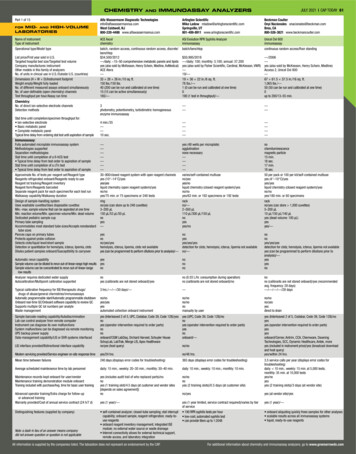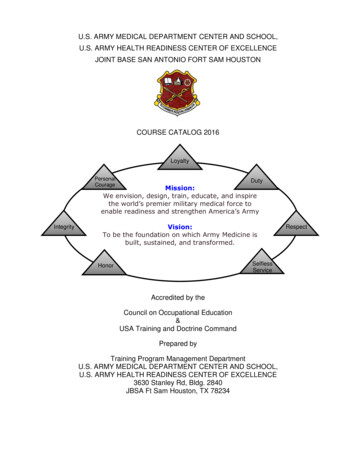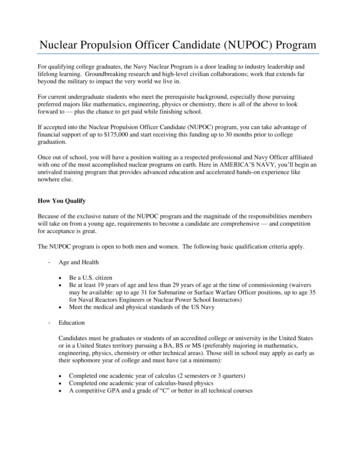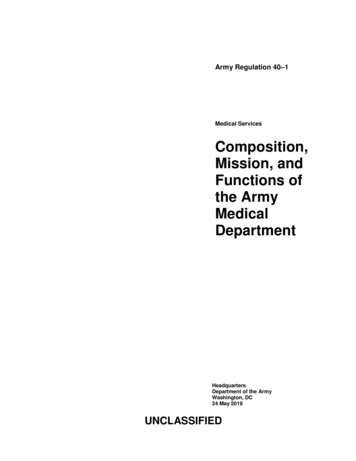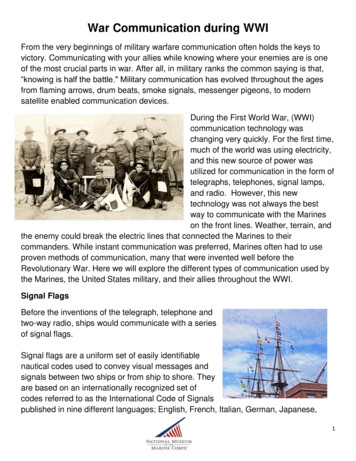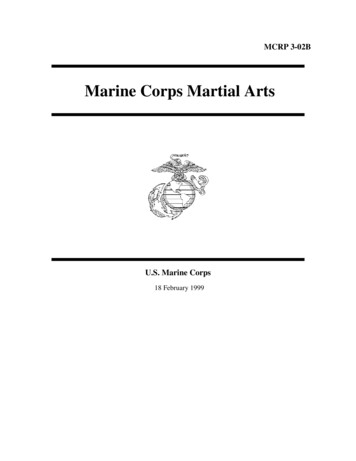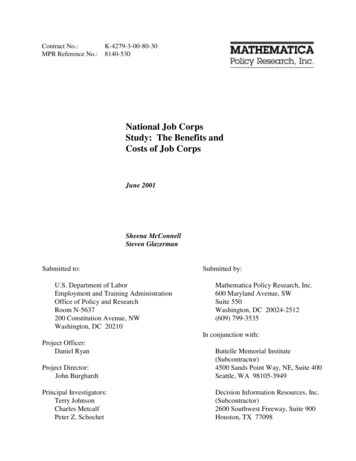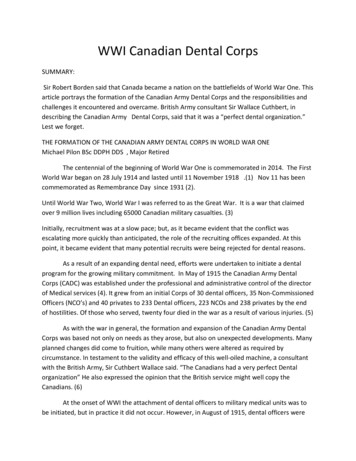
Transcription
WWI Canadian Dental CorpsSUMMARY:Sir Robert Borden said that Canada became a nation on the battlefields of World War One. Thisarticle portrays the formation of the Canadian Army Dental Corps and the responsibilities andchallenges it encountered and overcame. British Army consultant Sir Wallace Cuthbert, indescribing the Canadian Army Dental Corps, said that it was a “perfect dental organization.”Lest we forget.THE FORMATION OF THE CANADIAN ARMY DENTAL CORPS IN WORLD WAR ONEMichael Pilon BSc DDPH DDS , Major RetiredThe centennial of the beginning of World War One is commemorated in 2014. The FirstWorld War began on 28 July 1914 and lasted until 11 November 1918 .(1) Nov 11 has beencommemorated as Remembrance Day since 1931 (2).Until World War Two, World War I was referred to as the Great War. It is a war that claimedover 9 million lives including 65000 Canadian military casualties. (3)Initially, recruitment was at a slow pace; but, as it became evident that the conflict wasescalating more quickly than anticipated, the role of the recruiting offices expanded. At thispoint, it became evident that many potential recruits were being rejected for dental reasons.As a result of an expanding dental need, efforts were undertaken to initiate a dentalprogram for the growing military commitment. In May of 1915 the Canadian Army DentalCorps (CADC) was established under the professional and administrative control of the directorof Medical services (4). It grew from an initial Corps of 30 dental officers, 35 Non‐CommissionedOfficers (NCO’s) and 40 privates to 233 Dental officers, 223 NCOs and 238 privates by the endof hostilities. Of those who served, twenty four died in the war as a result of various injuries. (5)As with the war in general, the formation and expansion of the Canadian Army DentalCorps was based not only on needs as they arose, but also on unexpected developments. Manyplanned changes did come to fruition, while many others were altered as required bycircumstance. In testament to the validity and efficacy of this well‐oiled machine, a consultantwith the British Army, Sir Cuthbert Wallace said. “The Canadians had a very perfect Dentalorganization” He also expressed the opinion that the British service might well copy theCanadians. (6)At the onset of WWI the attachment of dental officers to military medical units was tobe initiated, but in practice it did not occur. However, in August of 1915, dental officers were
permaneently attacheed to field hoospitals. As such,sthey seerved both in Canada beeforeembarkation to Euroope as well as in Europe. They servedd in hospitalls in the UK, as well as at ornear the front lines in France, Grreece , Italy anda Belgiumm. (6).ormed severral functionss:CADC personnel eventually perfo DentalDinspecctions of all CanadianCsoldiers on arrrival in EnglaandDentalDinspecctions of all returningrsooldiers beforee embarkingg for CanadaaProvision of normalnpreveentative denntal careouthTreatment off wounds and trench moSpecial care forf reconstruuction surgery in speciall clinics (8)Inn January of 1947 the Caanadian Armmy Dental Coorps was designated the Royal CanaddianDental Coorps. In 19668, as a result of what soome consideer an ill‐concceived mergeer ( 7) of theethree serrvices , ( Armmy, Air Forcee, Navy) the Royal Canaddian Dental CCorps was ree‐named theCanadiann Forces Denntal Service. In October ofo 2013 the designation of Royal Canadian DenttalCorps (RCCDC) was reinstated. Frrom a historiical point, thhere are somme who feel that the RCDDC isdescendeed from the first militaryy dental servvice in the wworld. (8). Soome feel thatt Canada truulybecame a nation duee to the extremely strong military seervice of ourr combat trooops at Battlessuch as VimyVRidge, Ypres,Ythe Soomme and manymotherss. Along this vein, the Caanadian ArmmyDental Coorps too, waas born of neeed .It served and continnues to servve with distinnction andvalour.Pte Elgin M. Wansbroough while sserving withh the Canadiaan ExpeditioonaryForce in 19181was awwarded the MMilitary Meddal for bravery in action. Healso became a dentist after the wwarht J. Coons whilewservingg with the CCanadian Exppeditionary FForceCpl Dwighin 1918 wasw awardedd the Militaryy Medal for bravery undder fire in theefield. He alsoa becamee a dentist affter the Warr.
Maj. G. L. Cameron, whilewservin g with the CCanadian ExppeditionarystForce, 1 Canadian Innfantry Brigaade Group wwas woundeed andsubsequeently awardeed the Distinnguished Serrvice Order aand MID forrgallantry under enemmy fire.Pte Charles Bryce Climmo, while sserving with the Canadiaan ExpeditionaryForce durring WWI froom 1916 – 1919 was awwarded the DDistinguisheddConduct Medal for braveryb(the DCM is secoond only to tthe Victoria CCross fgallantry))Maj. Johnn F. Blair, whhile serving wwith 4FD Ammbulance CAAMC CanadiaanExpeditionary Force 19181was awwarded the DDistinguishedd Service Orrderfor conspicuous gallantry while uunder enemyy fireOFFICERS, NCCO’S ENLISTED CANADIAN ARMY DENTTALCCORPS LOCATTION UNKNOWWNFIELD DENTAAL CLINIC
DENTAL TRAINING UTTRECHT, NETHERLANDSCADC OFFICERONAMME AND /World Waar I casualtties2. ce‐day3. caasualties.aspp4. http:///www.cda‐adc.ca/ files//cda/aboutcda/historyy/HSPart5.pddf5. /6. The Story of the Royal Canadiaan Dental Coorps Lieuteenant Coloneel H.M. Jackson , MBE, EE.D.Octavo , Toronto 195567. My opinion8. eentalcorps.httm9. http:///en.wikipediia.org/wiki/LList of Canaadian battlees during thhe First Woorld War
ABOUT THE AUTHOR:Michael Pilon is a graduate of dentistry from McGill University. He also has a postdoctorate in Public health from the University of Toronto. He served in the Royal CanadianDental Corps for 23 years. His service posting include CFB Gagetown, Summerside, Borden,Ottawa, Chilliwack, Halifax and UN Duty in Cyprus. He served in several roles as a practitioner,instructor, base dental officer and headquarters duties. He also earned the coveted AirborneRegiment Paratrooper wings. He is now in private practice in Ottawa. After witnessing adesecration of the Cenotaph and the Tomb of the Unknown Soldier in Ottawa, Michael Pilonsingle handedly succeeded in ensuring that a proper and respectful environment bemaintained at this Monument which is a memorial to 110,000 Canadians who gave their lives inservice.
It grew from an initial Corps of 30 dental officers, 35 Non‐Commissioned Officers (NCO's) and 40 privates to 233 Dental officers, 223 NCOs and 238 privates by the end of hostilities.
